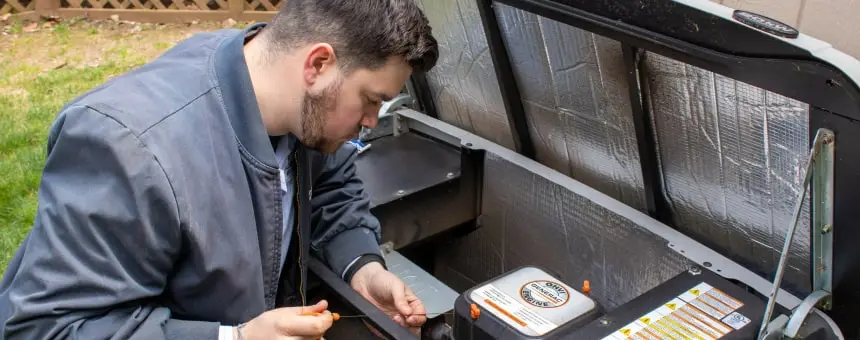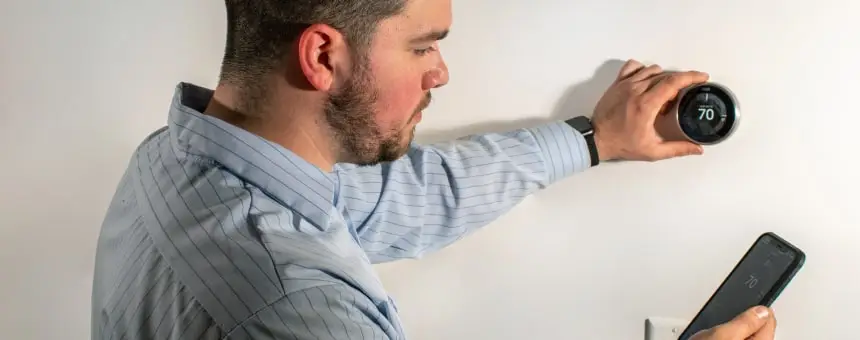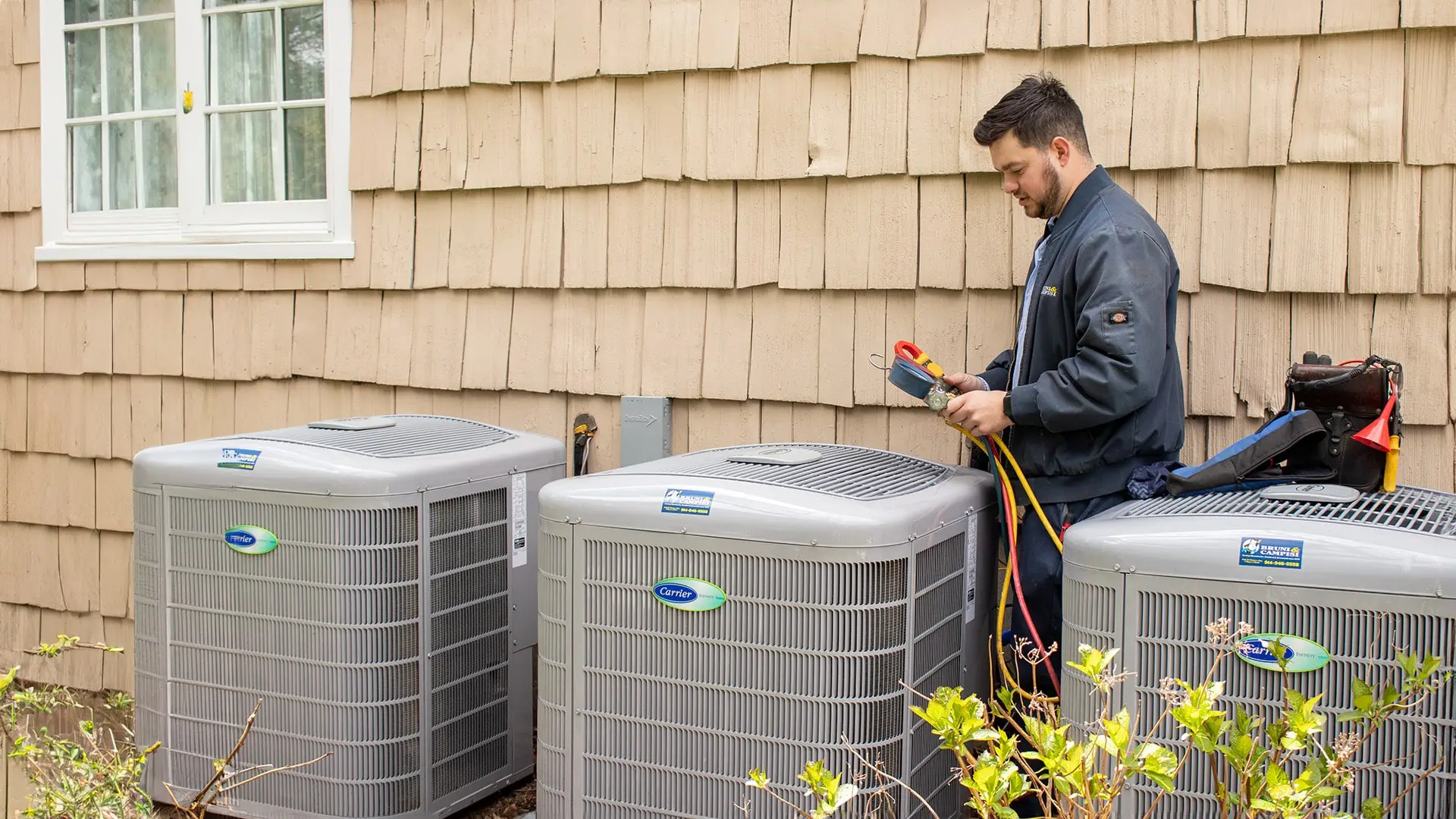Come summertime, an air conditioner operating at optimal efficiency is essential. No wonder air conditioning has become all but standard in American homes. In fact, according to the U.S. Department of Energy, 75 percent of American homes feature an air conditioner of one type or another. Additionally, air conditioning units use 6 percent of all electricity produced in the United States, costing American homeowners around $29 billion a year. On the face of it, this second statistic might seem daunting. Considering America’s increased focus on both environmental issues and cost efficiency, making an investment in energy use reduction would be wise for many homeowners.
However, regular home air conditioner maintenance does more than reduce energy consumption — it will also improve your air conditioner’s ability to keep you cool. As experts in A/C maintenance, we want to present you with the ultimate preventive maintenance checklist for air conditioners. As you prepare for the summer heat, you can rest easy knowing that your air conditioner will keep you nice and cool all season long.
AC Preventive Maintenance
Start with air filters and indoor coil.
- Make sure to clean your air filters.
- Kitchen antiseptic spray works well for cleaning. Just make sure to rinse with warm water.
- The key is to remove dust buildup, as this will impede airflow.
Next clean the outdoor unit, including the coil while checking airflow.
- Obstructions should be removed, as they will diminish airflow.
- The air outlet on the front of the system should be wiped down.
- Do a check on the airflow, and make sure the coil is unobstructed
Do an airflow check on both indoor and outdoor units.
- Start with the indoor unit and make sure you have good airflow.
- If the airflow is poor, you may have a failing fan motor or a blocked coil.
- If you have removed obstructions and airflow is still poor, it’s time for a professional checkup.
Look out for rust.
- You want to fix rust and corrosion immediately.
- A new coat of waterproof paint is sufficient for minor superficial rust.
- However, a professional will need to address any major rust damage.
Do a check on the heating and cooling modes to make sure they are switching properly.
- Switch your system between heating and cooling modes.
- If your air conditioner is struggling to make the switch, this is a good indication of more serious issues, and means you should contact a professional.
Check Air Filters and Indoor Coil
Remember, while your air conditioning unit is most likely outside, air conditioning efficiency starts inside. Your air conditioning unit is linked to your central duct system, using the same ductwork that your furnace uses during the winter.
Start with your indoor air filters. Many systems use replaceable, inexpensive filters. These should be replaced monthly, especially in older homes.
Other HVAC systems utilize permanent filters. Instead of regularly replacing these filters, you need to clean them. Cleaning is simple. A standard kitchen antiseptic spray works well. Just spray both sides of the filter and wipe clean, rinsing with warm water. When you’re done, your filters should be dust free.
Another indoor air conditioning appliance to include in your checklist is the HVAC evaporator or indoor coil. This is a device that assists with heat exchange. These are not standard in all central air conditioning systems, so many homeowners will not have one. But if you do, you also want to make sure to clean the coils to ensure they are working at peak efficiency.
If you are using indoor window units, you still need to look for dust and debris. As indoor units run, they will collect dust and debris from the air outside. Use a general cleaning spray to clean the indoor-facing vents of your units.
Check and Clean the Coil and Air Outlets on the Outdoor Unit
Now that you’ve checked the indoor items off your air conditioner maintenance checklist, it’s time to move to your outdoor unit.
Your first step is to look at the outdoor unit and see if there is any obvious debris or obstruction. Often, over the course of the winter, leaves, sticks and dirt will collect on the unit which could obstruct airflow. This debris should be removed.
It should also be noted that there are many after-market products sold to cover your outdoor unit during the winter. However, many homeowners report an increase in rust development after covering their units during the colder months. Because these covers seal the unit during the winter, moisture cannot escape, thus causing unseen corrosion. Some homeowners even report their unit fan locking due to rust the moment that they turn their A/C on for the first time in the year.
Next, you want to look more closely at the grate or foil filtering the airflow.
If you have coil fins — in which thin aluminum sheets cover the airflow — know that these can get bent, drastically impeding airflow. If you have coil fins that have been bent, you will want to purchase an affordable device known as a “fin comb.” This will allow you to bend the fins gently back into place.
If you have a more open grating system, make sure to use a cleaning solution to remove finer dust and debris, further increasing airflow.
Third, look inside and make sure the heat exchange coil is free of obstructions. If you see leaves or other debris, clear them out.
If you have window units, you still need to inspect the outside air flow vents of these units. In many cases, the same maintenance steps will apply.
Finally, run your air conditioning unit and inspect it as it is running to see if there are any airflow obstructions that you did not notice during your initial inspection. Don’t be afraid to listen to the fan as it is running to see if you can hear any grinding or the sound of a leaf caught in the fan.
Do not try to remove the obstruction while the air conditioning is running, but if you do notice something, turn the unit off again and see if the movement made it easier for you to clear out the remaining debris.
Check for Good Airflow From Both Indoor and Outdoor Units
Now that you’re confident that your units are debris-free, you want to go back inside while the air conditioning — whether central or window units — are running.
If you have window units, and especially if they are all the same brand and model, each should be running with the same strength. If there are any units that are lagging, it might be time to have them either serviced or replaced.
If you have a central unit, you still want to investigate airflow coming from your ductwork vents. Depending on the age and style of your home, there will likely be some vents that do a better job of pushing out cool air than others. Taller, older homes tend to have a harder time evenly distributing forced air on the upper floors. However, vents within the various regions of your home should be consistent.
If the airflow is poor or inconsistent, and you are confident that you have already cleared obstructions from the central unit, you may have a larger issue. It is most likely that a coil is being obstructed in a way that you cannot see without dismantling the unit, or your fan may be starting to fail. In either case, it is time to consult a professional.
In a moment like this, a professional may seem like an expense that you can avoid, but having an air conditioning system in this type of condition serviced will save you money in the long run.
Remember, you want to get as much life out of a central air conditioning system as you can, as the cost of replacement, especially if the unit is relatively new, will far outpace the cost of routine maintenance. Because these sorts of issues are common, diagnosing them will likely be easy and the repairs quick.
Check for Rust or Corrosion
Rust or corrosion is one of the first age issues that can start to tax an A/C unit. Because an air conditioner needs to be working at peak performance to be energy-efficient, you don’t want any corrosion slowing the fan or making the coil-less effective.
Additionally, like the paint job on a car, a little bit of rust can quickly start spread. That’s why you need to address even minor, seemingly cosmetic rust issues as soon as possible. While the rust may not be impeding the operation of your unit now, in a season or two, it is likely that the rust will spread and become a much more expensive concern.
If you are an intrepid do-it-yourselfer, you can use waterproof steel paint to address minor scuffs and superficial rust. This will stabilize the issue, although if you are strongly concerned about cosmetics, know that it may be difficult to match the paint perfectly.
Major rust issues always need to be addressed by a professional. While you may be able to diagnose rust as the cause of a fan problem, it’s likely that the damage extends beyond what a non-professional can observe. If the rust issue has gotten that bad, there’s a good chance it will also be damaging other, harder-to-see parts of your air conditioning unit.
Check Your System on Both Heating and Cooling Modes
The final step in the home A/C maintenance checklist is to make sure your HVAC system can switch between heating and cooling modes.
Once you’ve established that your system is operating well on cool, turn the thermostat to heating mode — making sure to adjust the thermostat to a warm-enough desired temperature to trigger heat — and see if it adjusts correctly.
This is an important test because it is the only way to determine if there is an issue with the reversing valve.
The reversing valve is an important piece of equipment that allows you to use many of the same components for both heating and cooling. If this crucial part isn’t working properly, you will need to contact a professional to have it replaced properly.
Important Air Conditioning Diagnostics Require a Professional
While the above checklist should become an essential and regular part of your yearly A/C preparations, there are air conditioning issues that require a professional. While you may not need to have these things checked annually, they are important enough that you should schedule professional maintenance regularly. Below is a list of things that should be left to a professional. You can also consider this as an air conditioner service checklist for when you do hire a professional.
HVAC maintenance professionals are required for the following issues:
- Precisely measuring airflow. As we mentioned above, you should be able to tell if your air conditioning airflow is sufficient. But you won’t have the kind of precision equipment needed to make sure that there isn’t a smaller obstruction in your evaporator coil. That’s why you should get a professional to diagnose an airflow problem if you suspect there is one but cannot clearly identify where the obstruction might be.
- Verify the electric control sequence controlling the reversing valve. If you are having problems switching between heating and cooling modes, you may have an issue with your reversing valve. However, you could also have a problem with the electric control sequence. You want to make sure a professional determines which of the two issues you are having trouble with. Remember, when it comes to electrical controls, do-it-yourself solutions can be dangerous. And depending on where you live, attempting a DIY electrical fix may be a code violation.
- Apply lubricant and check belts for tightness. You can usually spot rust and the problems that corrosion can cause. But other issues can impede the operation of your air conditioning fan. It may be a simple lubrication problem, or it could be an aging belt. Either way, because these parts are delicate and need to be perfectly installed to work properly, inspecting and maintaining these parts is a professional job.
- Check refrigerant levels, test for refrigerant leaks and capture refrigerant that needs to be evacuated. When it comes to a refrigerant, addressing it improperly isn’t just wasteful, it is illegal. That’s because these chemicals can have an enormous environmental impact if released improperly. You cannot spill or release refrigerant into the atmosphere. And if there is a leak, you are responsible as a homeowner for any damage that leak may cause. This is perhaps the most important reason to get a regular professional checkup on your air conditioning unit. It is vital that you not attempt to address refrigerant issues yourself.
- Tighten connections and re-apply non-conductive coating. Remember, the many parts in a central air conditioning unit are complicated and need to be installed correctly. Knowing what parts to tighten and how to do so in a way that won’t damage their non-conductive coating is crucial if you want an air conditioner that works the way you expect it to. Further, correctly making the adjustments often require tools that can’t be found in a common home toolbox.
- Look for duct leakage. This is another issue that could be sapping the efficiency of your airflow which can be hard to identify during your routine check. Your fan could be working perfectly, your filter can be brand-new and all ventilation might be unobstructed, yet you are still experiencing airflow issues.
In this case, it’s possible that you have duct leakage somewhere in your HVAC system. A professional will know what to look for and have the materials necessary to fix it. While the repair is minor, having a professional complete it will go a long way in improving energy efficiency, thus saving your money in the long run.
Contact Bruni & Campisi About Our AC Maintenance
If you live in Westchester County, N.Y., Stamford, Conn., Greenwich, Conn. or any of the surrounding areas, you can count on Bruni & Campisi for all your HVAC needs.
Since 1979, we have been providing the region with expert HVAC and plumbing care for both residential and commercial clients. Since then, we have earned a sterling reputation for reliability, quality and experience with the leading and most respected air conditioning brands in the country.
All our work is performed by licensed HVAC professionals, meaning you can feel confident that the experts diagnosing your air conditioning issues have received the training to get it right the first time.
Because our service staff is equally well-trained on heating systems as they are on cooling, you can be confident that our repairs and maintenance will ensure that both systems are working together as efficiently and effectively as possible.
In the event of an air conditioning emergency, we provide 24/7 emergency service. That way, if your air conditioning fails in the middle of a dangerous heat wave, you can get repairs done quickly, protecting your family.
To take the guesswork out of maintenance and repair costs, we offer free estimates and up-front, flat rates. That way, you won’t have to worry about unexpected costs tied to hourly labor.
If you are ready to set up a regular maintenance contract or you just want to talk to a professional about what you may need to get your air conditioner working like it did the day you had it installed, contact us.

AC System Buy Back Up To $1500
Get this dealCannot be combined with any other offers or memberships. Cannot be used on past work. Must be presented at time of proposal. Some exclusions may apply. See website for licensure. Offers Expire: 08/01/2025


MEMBERSHIPS
Bruni & Campisi offers a complete maintenance program for all your needs.
VIEW MEMBERSHIPS

